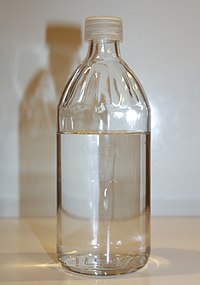
Photo from wikipedia
The equilibrium headspace concentration of nicotine in nitrogen gas was measured by gas chromatography for binary mixtures of nicotine with glycerol and with 1,2-propanediol at temperatures near 298.15 K. The… Click to show full abstract
The equilibrium headspace concentration of nicotine in nitrogen gas was measured by gas chromatography for binary mixtures of nicotine with glycerol and with 1,2-propanediol at temperatures near 298.15 K. The storage temperature ranged from 296.25 to 298.25 K. The nicotine mole fraction ranged from 0.0015 ± 0.00010 to 0.998 ± 0.0016 for the glycerol mixtures and 0.00506 ± 0.000019 to 0.999 ± 0.0038 for the 1,2-propanediol mixtures (k = 2 expanded uncertainty). The headspace concentration was converted to nicotine partial pressure at 298.15 K using the ideal gas law, followed by the Clausius–Clapeyron equation. Both solvent systems had a positive deviation of nicotine partial pressure from ideal behavior, but the deviation of the glycerol mixtures was much greater than that of the 1,2-propanediol mixtures. For mole fractions of about 0.02 or less, the glycerol mixtures had nicotine activity coefficients of 11, while that for the 1,2-propanediol mixtures was 1.5. The Henry′s law volatility constant and infinite dilution activity coefficient ± expanded uncertainty for nicotine from glycerol mixtures (51.4 ± 1.8 Pa and 12.4 ± 1.5, respectively) were approximately an order of magnitude greater than those from 1,2-propanediol mixtures (5.26 ± 0.52 Pa and 1.42 ± 0.14, respectively).
Journal Title: ACS Omega
Year Published: 2023
Link to full text (if available)
Share on Social Media: Sign Up to like & get
recommendations!